"The primary idea in all my works was to help the farmer and fill the poor man’s dinner pail ... My idea is to help the man farthest down. This is why I have made every process just as simple as I could to put it within his reach."
— George Washington Carver, January 16, 1929
Dr. George Washington Carver's Transformation from Slave to Student, Teacher, Inventor, and Plant Pathologist
| |
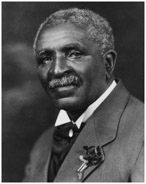 |
| |
George Washington Carver,
1864-1943 |
George Washington Carver was born a slave around 1864 on the Moses Carver plantation in Diamond Grove, Missouri, just one year after the emancipation proclamation. Dr. Carver experienced many adversities and obstacles in life, but he persevered to become one of the world’s greatest scientists and humanitarians. As an infant, George and his mother were kidnapped by bandits and taken to Arkansas where he was ransomed for a horse valued at $300. His mother was never heard from again. He was returned to the plantation of Moses and Susan Carver in Missouri where he was reared.
As a child, Carver was fascinated with nature including all kinds of organisms. With his foster mother, Susan Carver, he worked in the garden where he was said to have "a particular gift for nurturing plants." Because of this, he "soon became known around Diamond, Missouri as the plant doctor, and neighbors called on him frequently to nurture their sickly flowers and plants back to health" (Adair 1989, p. 21).
His early training was in a small, one-room school in Neosho, Missouri. He continued his education in Minneapolis, Kansas where he received a high school diploma. His desire for a formal education led him to enroll in Simpson College to study piano and art. He excelled in his studies but art instructor Etta Budd, whose father was head of the Iowa State College Department of Horticulture, recognized Carver’s horticultural talents. She convinced him to enroll and study agriculture at Iowa State College of Agriculture and Mechanic Arts. He received his Bachelors of Arts degree in Agriculture in 1894. Because of his proficiency in plant breeding, Carver was appointed to the faculty, becoming Iowa State’s first African American faculty member. Over the next two years, as assistant botanist for the Iowa Experiment Station, he developed his skill in plant pathology and mycology.
As a student at Iowa State College Agriculture and Mechanic Arts, Carver worked with two professors of botany and came to appreciate the diversity of fungi causing diseases of plants. Carver may have been especially influenced by one of his Iowa State professors, Dr. Louis H. Pammel, a scientist noted for his expertise in plant diseases, especially those caused by fungi. Dr. Pammel went on to study at Harvard University with W.G. Farlow, one of the most notable mycologists of the time. Dr. Pammel would later state that Carver was "the best collector I have ever had in the department or have ever known" (Adair 1989, p. 38).
In 1896, Dr. Carver completed his Master’s Degree in Agriculture from Iowa State College. He received many job offers immediately after obtaining his Master’s Degree. The United States’ first Historically Black Land Grant University for African Americans, Alcorn Agricultural and Mechanical College, located in Lorman, Mississippi, now Alcorn State University, was one of many colleges to invite Dr. Carver to join its faculty. However in 1896, George Washington Carver accepted an offer by Booker T. Washington to come to Tuskegee Institute and serve as the head of the newly established Department of Agriculture. Carver accepted the invitation and began work on October 8, 1896. In February of 1897, the legislature of the State of Alabama approved the establishment of the Tuskegee Agricultural Experiment Station. Carver accepted the responsibility of managing the Experiment Station in addition to serving as head of the Department of Agriculture. (Mayberry 1991).
At Tuskegee, as a botany and agriculture professor to the children of ex-slaves, Dr. Carver wanted to improve the lot of "the man farthest down," the poor, one-horse farmer at the mercy of the market and chained to land exhausted by cotton. Dr. Carver was visionary in his research in that he saw the need to develop sustainable farming methods for this type of farmer. He wanted to coax them away from cotton toward soil-enhancing, protein-rich crops such as soybeans and peanuts, and thus toward self-sufficiency and conservation. Dr. Carver accomplished this through an innovative series of free, simply written research bulletins (extension publications) that included information on crops, cultivation techniques, plant disease management strategies, and recipes for nutritious meals. He also urged farmers to submit soil and water samples for analysis and taught livestock care and food preservation techniques. In 1906 he designed the Jesup Wagon, a demonstration laboratory on wheels, as a means of extending the latest agricultural research developments directly to farmers in the field. In 1916 he published the bulletin "How to Grow the Peanut and 105 Ways of Preparing it for Human Consumption." Dr. Carver advocated the growth of peanuts instead of cotton. Livestock could eat the peanuts, and any unsold peanuts were left to the sharecroppers to feed their families.
Though the global peanut industry is indebted to Dr. Carver for his work in demonstrating the commercial potential of peanuts, a similarly important but little-known fact about Dr. George Washington Carver is his contribution to global food security and his work as a plant pathologist. He continued collecting fungi as a professor and Director of the Agricultural Experiment Station at Tuskegee. In the 1920’s and 1930’s, Dr. Carver was in close communication with a number of the mycologists who worked at the mycological collections in the Bureau of Plant Industry (BPI) in Washington, DC. The mycologists would identify the specimen sent to them by Dr. Carver and send their determination back to him. He deposited over 1,000 specimens of fungi primarily from the southeastern United States that document the fungal diseases affecting crops at that time. Dr. Carver’s fungal specimens are currently housed in the U.S. National Fungus Collection, formally BPI. Fortunately, the USDA has computerized the data from all of the one million specimens in the U.S. national fungus collections, and are able to extract information about those deposited by Dr. Carver.
The interaction between Dr. Carver and the mycologists was essential in identifying fungi occurring in the United States in order to develop control measures such as breeding for resistance to the diseases of the agricultural crops. This paper will highlight a variety of archival data such as the correspondence between Dr. Carver and the USDA mycologists, photos of specimens he deposited, and historical implications of his disease survey.
Collaborator USDA Bureau of Plant Industry Division Mycology and Plant Disease Survey
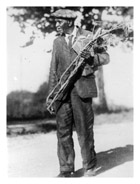 |
|
| Carver collecting plant samples. (Photo courtesy Alabama Department of Archives and History) |
|
As previously noted, during his lifetime G.W. Carver sent over 1,100 specimens of fungi that were identified by himself or scientists at the USDA to the U.S. National Fungus Collections where they have been accessioned in the specimen information databases. The data from these specimens have been extracted from the main database as a spreadsheet and analyzed to provide the data here.
The numerous specimens deposited at the U.S. National Fungus Collections (BPI) suggest that Carver had a keen eye for fungi that cause diseases both on crop plants and on wild plants in the nearby agricultural fields. Although Carver collected quite a few specimens as a graduate student at Iowa State in 1896-1897 most of his specimens were collected when he was in his 70’s with most specimens collected in 1935 (303 specimens) and 1936 (335 specimens). However, he collected fungal specimens throughout his career. A list of over 800 specimens of fungi collected by G. W. Carver was published by Lentz & Stevenson (1948) with references in which these specimens were reported. Fungal specimens exist also at other herbaria with 100 specimens at the New York Botanical Garden (NYB), and at least 174 specimens at the Iowa State University Ada Hayden Herbarium (ISC) (Deborah Lewis, personal communication).
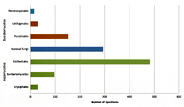 |
| Phyla and orders of fungi deposited by Dr. George Washington Carver, 1896-1943. |
A majority of the fungi that Carver collected belong to the Ascomycetes, the group that includes most of the plant pathogenic fungi (see graph above). Out of the over 1,100 specimens collected by Carver, 902 are Ascomycetes distributed among the major groups as follows: Erysiphales (powdery mildews) 30 specimens, Sordariomycetes (unitunicate ascomycetes) 483 specimens, Dothideomycetes (bitunicate ascomycetes) 96 specimens, and asexual fungi that could be in either of the latter two groups, 293 specimens (see graph). Among the other fungi collected by Carver are 152 specimens of rust fungi (Uredinales), 30 smut fungi (Ustilaginales), plus six specimens of miscellaneous basidiomycetes of which only three were Agaricales (mushrooms). Also, Carver collected 15 specimens of the Peronosporales (downy mildews). Obviously Carver’s emphasis in collecting fungi was the disease-causing fungi of plants. After leaving Iowa, the majority of Carver’s specimens were collected in Alabama with some from the neighboring states of Florida, Louisiana, and Mississippi. The fungal specimens that Carver collected are from a diversity of plant hosts, but primarily not on crop plants. Only six of the fungal specimens are from the crops most closely associated with Carver, namely peanut, Arachis hypogea, and five from sweet potato, Ipomoea spp.
A number of new species were named for George Washington Carver including Metasphaeria carveri described by Ellis and Everhart (1902), a fungus that occurs on several economically important hosts. Another species, Cercospora carveriana Sacc. & D. Sacc. 1906, was originally described as C. richardsoniae Ellis & Everh, based on a specimen collected by G.W. Carver on the plant host Richardia scabra (as Richardsonia scabra) in Alabama (Fig. 6 ). The host is a small herb in the Rubiaceae that is native to the southeastern United States, with the common name rough Mexican clover or Florida pusley. The name C. richardsoniae was published on 30 June 1902 while that same name was published for another fungus on 23 June 1902. Because the Ellis & Everhart’s name was a later homonym, Saccardo & Saccardo (1906) established a replacement name that honored the collector of the type specimen, G.W. Carver, and thus was known as C. carveriana Sacc. & D. Sacc., now placed in the genus Pseudocercospora as P. carveriana (Sacc. & D. Sacc.) Crous & M.P. S. Camara in Crous et al. (1999). Although the type specimen was not collected by Carver, the species, Taphrina caveri Jenkins, was described in his honor because "…Carver appears to have been the first to observe the asci of this species of Taphrina ... [thus] it seems particularly fitting that it be named in his honor" (Jenkins 1939, p. 229). Pestalotia carveri Guba was also "named after the collector, the late Dr. George Washington Carver, naturalist, scientist, and correspondent ..." (Guba, 1961, p. 128). This species has since been transferred to the genus Pestalotiopsis as P. carveri (Guba) P.L. Zhu, Q.X. Ge & T. Xu 1991. Type or other specimens for all of these fungi are available at the U.S. National Fungus Collections (BPI).
Although Carver worked closely with mycologist Paul R. Miller on fungal diseases of the peanut, Miller also encouraged Carver to make general collections of fungi and send them to the USDA where they were deposited in the U.S. National Fungus Collections in Beltsville, Maryland. Considerable correspondence exists between Carver and mycologists at the USDA who identified the many fungal specimens collected and sent by Carver. From 26 January 1933 until 5 July 1935 the correspondence was with Cornelius L. Shear, Principal Pathologist in Charge, later Senior Mycologist in Charge, and Director of the Mycology and Plant Disease Survey, Bureau of Plant Industry, Washington, DC. From 10 August 1935 to 3 July 1942, only six months before the end of Carver’s life, the correspondence was with John Stevenson, Senior Mycologist in Charge, Mycological Collections. Considerable correspondence also exists between Carver and Anna Jenkins, Associate Mycologist, from 31 August 1938 to 17 June 1940 when she was working on the description of the new species of Taphrina, based on a specimen that Carver collected (see above). Shear, Stevenson, Jenkins and a number of mycologists worked on the identification of the fungal specimens and greatly appreciated the importance of these collections in exploring fungi in the United States. During the earlier part of the 20th century, fungi especially microfungi were particularly unknown in the southern states.
As a result of his active collecting of fungal specimens, Dr. Shear requested that Carver be appointed as a Collaborator for the USDA Bureau of Plant Industry Division, Mycology and Plant Disease Survey. This became official on 1 August 1935 (see photos of Dr. Carver’s appointment papers and letter of acceptance, below).
|
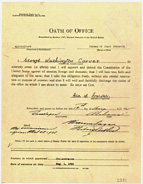
|
|
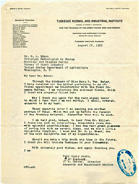 |
| Dr. George Washington Carver’s official Collaborator appointment documents from the USDA Bureau of Plant Industry Division of Mycology and Plant Disease Survey, and his letter accepting the offer. (National Agricultural Library). |
The U.S. National Fungus Collections (BPI) is the "Smithsonian" for fungi because the reference collections of fungi from the USDA were combined with those of the Smithsonian in 1895. Having the official acronym of BPI derived from the old Bureau of Plant Industry, the U.S. National Fungus Collections in Beltsville, Maryland, are part of the Systematic Mycology & Microbiology Laboratory of the Agricultural Research Service. The Collections consists of about one million dried specimens that are sent on loan to scientists throughout the world. Most of the data from the specimens have been computerized for studies such as the present one concerned with the collections of G. W. Carver. The specimens are housed in metal cabinets in a climate-controlled environment where they will be maintained in perpetuity. For years, the U.S. National Fungus Collections maintained historical archives including the correspondence of associated personnel. These archives were recently deposited at the National Agricultural Library. Within these archives are the letters of G. W. Carver with the mycologists associated with the U.S. National Fungus Collections, newspaper clippings, magazine articles, and associated items about G. W. Carver. The letters have been scanned and are available online.
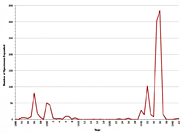 |
|
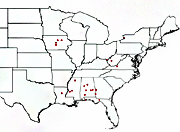 |
| Years and numbers of fungal specimens collected by Dr. George Washington Carver, 1896-1943. |
|
Map of locations in United States from which fungal specimens were collected by George Washington Carver, 1896-1943. |
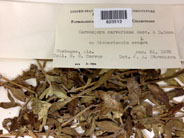 |
| Cercospora carveriana Saccr. & D. Sacc. on Richardsonia scalar collected by G. W. Carver and named in his honor (carveriana). (National Fungus Collections) |
Visit to the U.S. National Fungus Collections to View Dr. George Washington Carver’s Fungal Specimens
 |
|
| Examining G. W. Carver’s correspondence with USDA Mycologist concerning plant disease survey. (Photo D. Collins) |
|
In August of 2013, two of the authors — Dr. Herman Warren, Professor Emeritus of Plant Pathology, Virginia Tech University, Blacksburg, VA, and Daniel J. Collins, Professor of Plant Pathology, and Chair Department of Agriculture, Alcorn State University, Lorman, MS — visited Dr. Amy Rossman, Research Leader Systematic Mycology & Microbiology Laboratory, Beltsville, MD, to view firsthand a wide variety of archival data concerning Dr. Carver’s contributions to Global Food security such as fungal specimen deposited in the U. S. National Fungus Collections, correspondence between Carver and the USDA Mycologist (1920-43), newspaper articles, and publications.
The visit to view Carver’s fungal specimens, his typed and handwritten correspondence, and related archives was a very inspirational event. It certainly was a pleasure researching a little known part of Dr. Carver’s life history and work as a plant pathologist. Holding in hand and reading the official letters appointing Dr. Carver, an African American plant pathologist, to the post of an official Collaborator for the USDA Bureau of Plant Industry Division, Mycology and Plant Disease Survey was an emotional experience. All of the authors could relate to the specimens he deposited and the locations from which collections were made, in that we have conducted research, taught classes, carried out extension projects on disease specimen he collected, and/or visited the locations where he collected specimens.
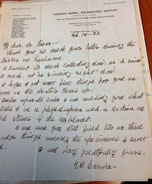 |
| Carver’s handwritten letters to Dr. Shear. |
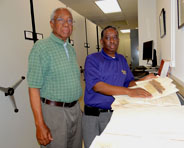 |
|
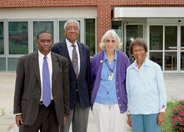 |
| Examining Diplodia zeao on sample collected by G. W. Carver. Dr. Warren is a retired corn pathologist at USDA-ARS and Professor Emeritus at Virginia Tech University. (Photo D. Collins) |
|
Daniel Collins, Herman Warren, Amy Rossman, and Mary Warren at the USDA-ARS Beltsville Agriculture Research Center, Beltsville, MD. (Photo D. Collins) |
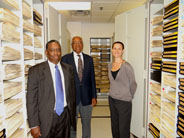 |
| Visiting with Shannon Dominick, U.S. National Fungus Collections, Beltsville, MD. (Photo D. Collins) |
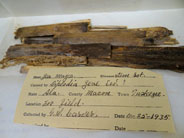 |
|
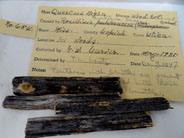 |
| Diplodia zeae on corn (Zea mays) collected by G. W. Carver on November 25, 1935 in Tuskegee Macon County, AL. (National Fungus Collections) |
|
Rosellinia ambigna specimen from black oak (Querus nigra) collected by G. W. Carver in May 1931 from Utica in Copiah County, MS. (National Fungus Collections) |
Carver’s Plant Disease Collections In Mississippi Have Historical Implications
An examination of the data on the specimens deposited by Carver in the National Fungus Collections reveals that the majority were from Tuskegee, Alabama. However, he did make a number of collections in other states, specifically in the southeastern United States.
| |
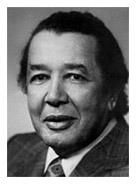 |
|
| |
Dr. Richard Morrison, former President Alabama A & M University, Huntsville, AL. Dr. Morrison is a native of Utica, MS. (Photo: Alabama A & M University) |
|
Because of his technological and scientific achievements in agriculture, Dr. Carver’s fame and notoriety grew. He received numerous invitations for speaking engagements from both white and black citizens (this was quite remarkable given the segregation laws in the southern United States at that time). He spoke in venues such as farmer’s conferences, colleges, universities, schools, and churches. It appears that he also collected plant disease specimens while traveling for speaking engagements in other states. He deposited four fungal specimens from Mississippi as a Collaborator with the Plant Disease Survey. In a program booklet recognizing Carver for his "Forty Years of Creative Research and Achievement," Millsaps College, at the time an all-white Methodist school located in Jackson, Mississippi, is mentioned as one of the colleges where Dr. Carver spoke. Carver deposited a Uromyces hordei specimen on Hordeum pusillum (little barley) collected May 15, 1932 in Jackson. (Fig 6). From Utica, Mississippi, Carver deposited a number of samples including a Rosellinia ambigna specimen from black oak (Querus nigra). Utica, MS, holds much historical significance as a result of Hinds Agricultural High School being located on the Hinds Community College campus. The school lies in both Hinds and Copiah County Mississippi. The High School and Community College offers an agricultural curriculum. Hinds Agriculture High School located in Utica, MS, on the Utica campus of Hinds Community College was founded 27 October 1903 as the Utica Normal and Industrial Institute, Colored. Its founder and principal was William H. Hotzclaw who was a student of Booker T. Washington, President of Tuskegee Institute. Utica Institute emphasized the basics of reading, writing, arithmetic, home economics, and agriculture. The School became known for the Farmers Conference, led by Holtzclaw’s colleague and friend Dr. Carver.
Dr. Carver served the school each summer as a consultant to farmers in the area and the school became known for its specialty in agriculture. (Hopkins-Davis 2013). The late Dr. Richard Morrison, former President of Alabama A & M University and a native of Utica, MS (pictured above), was a revered and exemplary educator and legendary advocate for 1890 Land-Grant Institutions. That devotion found its genesis in his hometown of Utica, MS, where he developed a love for agriculture and its potential for bringing economic freedom. While still in high school he met his mentor, Dr. Carver. Morrison later enrolled at Tuskegee University and graduated with a degree in agriculture. The Cooperative Extension building on Tuskegee’s campus, Morrison-Mayberry Hall, is named in his honor.
Pictorial Comparison of G. W. Carver Fungal Plant Diseases Samples with Present Day Diseased Specimens
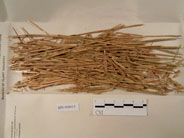 |
|
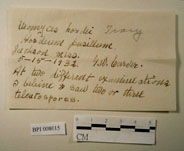 |
|
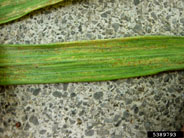 |
| Uromyces hordei on Hordeum pusillum (little barley) collected by G. W. Carver on May 15, 1932, Jackson, MS. (National Fungus Collections) |
|
Dr. G. W. Carver's handwritten description of diseased little barley specimen. (National Fungus Collections) |
|
Leaf rust on barley Piccinia hordei. (Photo Elizabeth Bush, Virginia Tech University, Bugwood.org) |
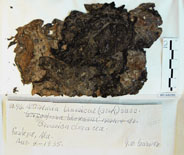 |
|
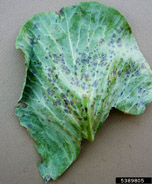 |
|
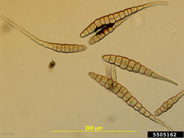 |
| Black spot of brassicae caused by the fungus Alternaria brassicae collected by G. W. Carver on August 4, 1935, Macon County, AL. (National Fungus Collections) |
|
Black spot on cabbage. (Photo Elizabeth Bush, Virginia Tech University, Bugwood.org) |
|
Alteraria brassicae conidia. (Photo Bruce Watt, University of Maine, Bugwood.org) |
The Legacy of Dr. George Washington Carver
The Morrill Act of 1862 established land-grant universities that laid the foundation for the nation’s public university system. The second Morrill Act of 1890 established Black land-grant universities, 28 years after passage of the first Morrill Act. Historically Black land-grant universities are located in 18 states, the District of Columbia and the U.S. Virgin Islands. Dr. George Washington Carver’s history and legacy is inseparable from the history of U.S. Land-Grant Institutions both 1862 and 1890 Institutions. Dr. Carver’s education and training in plant pathology and mycology began at Iowa State College, an 1862 University. He spent the majority of his career and achieved some of his greatest accomplishments as a faculty member and administrator at an 1890 institution, Tuskegee University.
| |
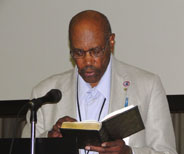
|
| |
Dr. Lafayette Frederick |
George Washington Carver is a world renowned scientist. Dr. Lafayette Frederick, Professor Emeritus of Biology at Howard University and currently Visiting Scientist at Tuskegee University summarizes the legacy of Dr. Carver in the foreword to Linda O. McMurry’s George Washington Carver: Scientist and Symbol:
He stood out as an embodiment of an example of what could be accomplished by a black person if granted only minimal opportunity to develop one’s talents. He represented for many an example of the rewards that could accrue from diligent study, high motivation, taking advantage of opportunities, faith in a Creator, and compassion for others.
Dr. Frederick was a student at Tuskegee Institute now Tuskegee University, during the last three years of Carver’s life. He states although Carver was scarcely visible and a strongly retiring person at that time, the mystique of the Carver presence, particularly for those of us who were agriculture majors, was intense, pervasive, and motivational.
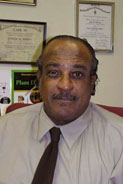 |
|
| Dr. Clauzell Stevens II, 1944-2009, Professor of Plant Pathology, George Washington Carver Agricultural Experiment Station, Tuskegee University. Dr. Stevens' and Dr. Carver's lab were both in Milbank Hall on the campus of Tuskegee University. (Photo courtesy Brenda Stevens) |
|
The impetus for writing this account of Dr. Carver’s plant disease survey came from both Drs. Herman Warren and Lafayette Frederick during a discussion we were having about who the first African American to become a plant pathologist might have been. Dr. Carver’s name came up right away. Because Dr. Frederick had seen the data and the archival of Dr. Carver’s specimens and was aware of a prior publication "A Resume of the Fungus Collections of George W. Carver," (Paul L. Lentz and John A. Stevenson, Plant Disease Reporter, vol. 32, No.5, May 15, 1948), we decided to do the research and shed more light on a little-known aspect of Carver’s work. An account of Dr. Carver’s specimens deposited at the USDA Fungus Herbarium was written previously by Paul L. Lentz and John A. Stevenson.
A longtime friend and colleague of ours, and a mentor of mine, the late Dr. Clauzell Stevens, was born one year after the death of Dr. Carver.
Dr. Stevens was a professor of plant pathology in the Department of Agriculture at the George Washington Carver Agricultural Experiment Station, Tuskegee University, 1980-2009. He continued the legacy Dr. Carver began in plant pathology research and technology transfer to limited resource farmers. He was instrumental in developing plasticulture research activities such as plastic mulch systems, drip irrigation, and soil solarization for plant disease management. Dr. Stevens, like Dr. Carver, received international recognition for his research.
The legacy of Dr. George Washington Carver, African American Plant Pathologist, lives on through the lifetime achievements of those he mentored, worked with, taught, and through the countless others who have read his story and dreamed similar dreams and had a thirst for knowledge. Land-grant colleges and universities (1862, 1890, and 1994), are faced with the challenge of preparing the next generation of plant pathologists to continue his legacy of developing innovative research, education, and extension activities for the global society.
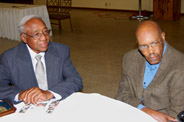 |
| Dr. Warren and Dr. Frederick discussing legacy of Dr. George Washington Carver. (Photo Daniel Collins) |
Acknowledgements
Amy Rossman wishes to thank Steve Eberhardt for manipulating the specimen data and to express her appreciation to Megan Romberg for making the figures.
Daniel Collins thanks Dr. Jairo Diaz, Department of Agriculture, Alcorn State University, for making the map, Lauren Collins for editing, and Doris Collins for editorial assistance and photography.
Additional Resources
Reflections on Dr. George Washington Carver by Drs. Daniel Collins, Herman Warren, and Lafayette Frederick at Global Food Security & Plant BioSecurity Symposium
(YouTube video) youtu.be/7Vk0JKeZLYw
Legacy of Dr. George Washington Carver Tuskegee University
George Washington Carver Digital Collections Iowa State University Library
Learn about George Washington Carver National Agricultural Library
References
Crous, P. W., Braun, U., and Alfenas, A. C. 1999. Cercosporoid fungi from Brazil. 3. Mycotaxon 72:171-193.
Ellis, J. B., and Everhart, B. M. 1902. New Alabama fungi. J. Mycol. 8:62-73.
Guba, E. F. 1961. Monograph of Monochaetia and Pestalotia. Harvard Univ. Press, Cambridge, MA.Hopkins-Davis, S. 2013. Historical Developments of Hinds Agricultural High School. Campus Dean of Instruction/Academic Affairs and Technical Education, Utica, MS
Huntsville Times July 30, 2011. AAMU announces passing of former president Dr. Richard Morrison. Huntsville, AL.
Lentz, P. L., and Stevens, J. A. 1948. A resume of the fungus collections of George Washington Carver. Vol. 32, No. 5, Plant Disease Reporter USDA. May 15, 1948.
Jenkins, A. E. 1939. New species of Taphrina on red maple and on silver maple. J. Washington Acad. Sci. 29:222-230.
Mayberry, B. D. 1989. The Role of Tuskegee University in the Development of the Negro Cooperative Extension System 1881-1990. Tuskegee Univ. Coop. Ext. Prog., Tuskegee Institute, AL, October 1989.
Mayberry, B. D. 1991. Lengthening Shadows of George Washington Carver. Statement by B. D. Mayberry at the workshop on understanding and manipulating plant responses to environmental stress. September 15, 1991 at Tuskegee University, AL.
McMurry, L. O. 1994. George Washington Carver Scientist and Symbol. Foreword by Lafayette Frederick. Collector’s Edition. The Easton Press, Norwalk, CT.
